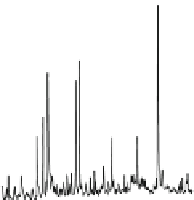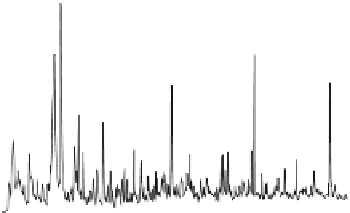Geology Reference
In-Depth Information
a
Undecayed shrimp cuticle
b
d
m/z
85+83
1
a
d
7
d
2
2
3
d
8
c
4
5
6
9
11
12
12
b
After 4 weeks of decay
1
m/z
85+83
b
7
d
X
C
20
2
C
24
X
X
X
X
X
X
6
2
8
a
9
10
5
d
d
3
d
c
12
11
12
c
After 44 weeks of decay
d
b
m/z
85+83
a
C
20
C
24
X
X
X
X
X
X
9
10
X
c
11
12
12
Retention time
Fig. 6.2
Analysis of undecayed shrimp cuticle (
a
), shrimp decayed for 4 weeks (
b
), and 44 weeks
(
c
) revealing presence of diagnostic chitin-protein moieties using py-GC-MS. Note the presence of
the
n
-alkyl component (alkane/alkene peaks, denoted by X) up to C
24
in the 4 week and 44 week
decayed sample, and clear decrease in relative abundance of proteinaceous moieties after 44 weeks
of decay. Numbers annotated on peaks refer to protein derived pyrolysis moieties and letters to
those related to chitin.
1
: toluene,
2
: C
1
pyrrole,
3
: C
2
benzene,
4
: styrene,
5
: C
2
-pyrrole,
6
: phenol,
7
: C
1
-phenol,
8
: ethylcyanobenzene,
9
: propylcyanobenzene,
10
: C
1
-indole,
11
: diketodipyrrole,
12
: 2,5 diketopiperazine structure (base peak at 70 Da, M
+
is 168 Da for proline-alanine and
194 Da for Pro-Pro),
a
: 3-acetamidofuran,
b
: 3-acetamido-5-methylfuran,
c
: 3-acetamido-4-
pyrone,
d
: oxazoline structure (base peak at 84 Da). In C
n
'n' refers to the number of carbon atoms
in the alkyl component
44 weeks (Fig.
6.4c
). There is minimal difference between the fresh and degraded
(44 week) scorpion cuticle. However, there is considerable enrichment in aliphatic
carbon (at ~30 ppm) in the 44 week decayed shrimp cuticle compared to undecayed
shrimp, and compared to the 44 week decayed scorpion cuticle, confi rming the
































Search WWH ::

Custom Search